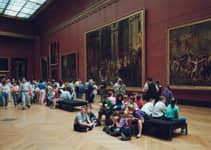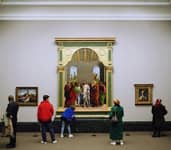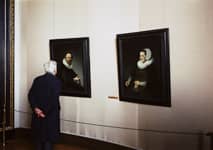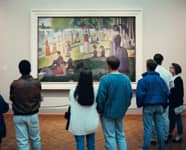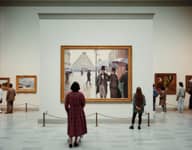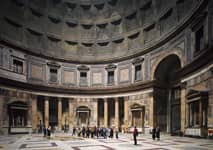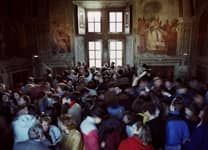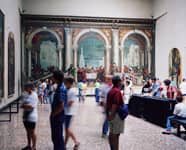In pictorial terms, a portrait Struth had made of Giles Robertson at his home in Edinburgh in 1987 was significant. He photographed the art historian looking at a book with three historic paintings from the 17th or 18th century on the wall in the background. Struth recalls “this suggested to me the potential for including a marriage of a contemporary moment and a historical moment in one photographic plane.” The photograph of The Restorers at the former refectory of San Lorenzo Maggiore in Naples encouraged Struth to explore further the possibilities of pictures of people with pictures in them and Giulia Zorzetti with a painting by Francesco de Mura established the possibility for a different scale of work.
He began to work at the Louvre and the Musée d’Orsay in Paris in June 1989. The choices of rooms and subjects were initially quite spontaneous, partly to do with an interest in the motifs or with the configurations of figures in the paintings: David’s Coronation of Napoleon with a school group in the foreground; Delacroix’s The Death of Sardanapalus; a crowd waiting to look at the Mona Lisa; and a work combining the existential drama of Géricault’s The Raft of the Medusa with the presence of a group of Japanese viewers. “The idea behind the museum photographs was to retrieve masterpieces from the fate of fame, to recover them from their status as iconic paintings, to remind us that these were works which were created in a contemporary moment, by artists who had everyday lives. They can be admired but revering the artist and their work can also be an impediment. In essence, I wanted to bring together the time of the picture and the time of the viewer.”
With the exception of a photograph from the Rijksmuseum with a friend of Struth’s sitting in front of a Rembrandt group portrait, the Museum Photographs were not staged. Struth preferred to observe and wait patiently for the work to form itself through the right configuration of people and pictures within the frame he had established in the gallery. Diverging from this working method was necessary for a work Struth wanted to make in the interior of the Pantheon in Rome. Struth first made a black-and-white picture in the Pantheon but the continuous movement of people and the limited light made it impossible to obtain a result.
During the same visit to Rome, he also made two photographs in the Stanze di Raffaello in the Musei Vaticani. One, with a frenzied crowd of visitors, prefigures subsequent series of works made in the Hermitage Museum in St. Petersburg and the Museo del Prado in Madrid.
Struth has occasionally revisited the theme of the Museum Photographs since the initial concentrated period of work in 1989 and 1990. In 1992 he made two works at the Galleria dell’Accademia in Venice, and in 1994 photographed people looking at abstract paintings at the Museum of Modern Art in New York. From various trials in rooms with paintings by Pollock, Mondrian, Barnett Newman and Rothko, eventually Struth exhibited only the photograph of people looking at Jackson Pollock’s painting One: Number 31 from 1950.

